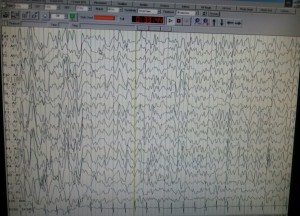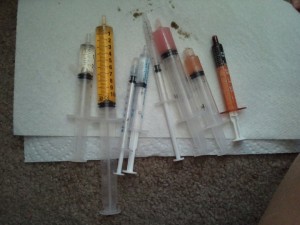
Hannah's EEG - Nov 2010
Hannah had her EEG today at her new neuro’s office.
The past 5 EEGs she has had, including her 24-hour EEG in the PICU this summer, had all comed back normal.
Today’s was not normal.
Hannah had fallen asleep pretty much immediately after the test began, so they were able to get a clean EEG. Once she had fallen into a deeper sleep, her nurse and I noticed the seizures on the screen. The EEG tech also confirmed they were seizures (even though she was not supposed to). They were happening every 30 seconds or so towards the end of testing when she was in a deeper sleep.
The interesting thing was that what we thought was Hannah’s movements from her movement disorder during her sleep was actually seizure activity. Every time Hannah twitched in her sleep, a seizure was noticed on the EEG (see pic on the left side – that is a seizure).
What this means? Progression, obviously. However to what extent is what needs to be researched. We meet with the neuro on 12/3 to come up with a game plan. She is already on Keppra so does that mean the Keppra has been blocking some of the seizure activity perhaps, maybe not?
I talked to Dr. Goker-Alpan, Hannah’s pediatrician from the NIH, today afterwards. She reassured me that these seizures are somewhat common in type 3 patients and are not as worrisome as I felt they were. The fact that she is not becoming hypoxic, her O2 saturations don’t drop, and she does not have any shaking activity means that it is not as intense as I feared. I’m going to send her and her other specialists a copy of the EEG report when I get it.
Progressive myoclonic epilepsy is documented in kids with neuronopathic Gaucher disease. After reading the description on Wikipedia, it sounds like it could match the symptoms Hannah has. “Myoclonic seizures involve brief involuntary muscle twitching, and may become frequent enough to be disabling….Tonic-clonic seizures have two phases: the tonic phase may last a few seconds and involves the muscles tensing, and may lead to the person falling down; the clonic phase involves a convulsion of rapidly alternating muscle tensing and relaxing. Neurological dysfunction includes difficulty coordinating muscle movements (ataxia) and a decline in cognitive ability (dementia).”
Regardless, it just sucks.



Latest Comments